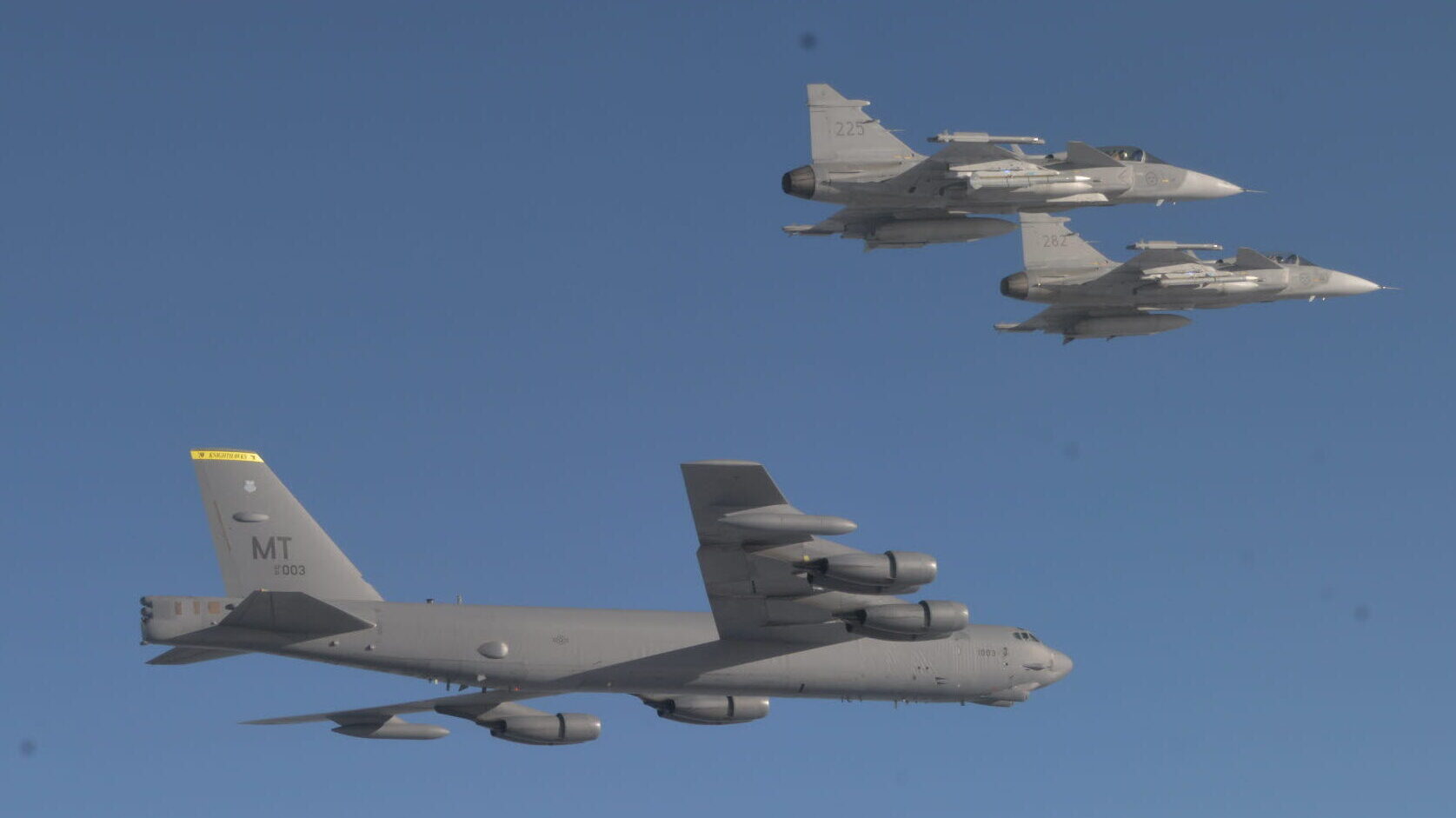
JAS 39 Gripen fighter jets escort a US B-52 Stratofortress from Bomber Task Force over Swedish airspace (Saab)
DUBLIN – A leading defense think tank has called on international policymakers to consider supplying the Ukrainian Air Force with Saab JAS 39 Gripen C/D fighter jets.
Authors from the UK-based Royal United Services Institute (RUSI) said in a report Monday that after looking at the Russian air war and requirements for Ukrainian air defense, the Swedish aircraft was “by far the most suitable candidate” of Western-manufactured combat jets that could meet operational needs.
Transfer of Gripens would advance Ukrainian short- to medium-term planning by minimizing the risk of sustaining Russian long-range missile strikes, according to the report.
The authors also warned that delivery of the aircraft, alongside SAM launchers, missile ammunition and self-propelled anti-aircraft guns are all critical to preventing a new Russian strike campaign, which, if not contested, could lead to a dramatic shift in the current momentum of the war.
“Conceptually, the Swedish Air Force has always emphasised low-level air superiority tactics from dispersed bases, in a similar manner to how the Ukrainian Air Force currently operates, and so the Gripen was designed with ground support equipment and maintenance requirements compatible with that approach,” stated the publication. “The electronic warfare suite on the Gripen C/D is also optimised specifically for countering Russian fighter and SAM radars.”
RELATED: The US military now seems open to gifting Ukraine new fighter jets, but what type?
Additionally, the authors cite Gripen’s anti-ship capability and integration of MBDA’s Meteor beyond-visual-range air-to-air missile (BVRAAM) and ramjet propulsion design being “less adversely affected” by counterthreats, compared to weapons with rocket-powered propulsion. Air launched weapons relying on rocket powered technology are widely considered to be more exposed to ground based threats because of their “low and slow” capability profiles.
“Since April, VKS [Russian Air Force] pilots have been extremely reluctant to aggressively fight their way into Ukrainian airspace due to the losses taken during early attempts,” note the RUSI authors. “The threat of Ukrainian SAM and MANPADS engagements has shaped the behaviour and constrained the effectiveness of Russian pilots significantly.
“Therefore, even a few modern Western fighters with long-range missiles able to meet the Russians on technically equal or even superior terms would likely have a disproportionate deterrent effect.”
Despite such analysis reopening debate over whether or not European or US decision makers should approve Western-made fighter jets being sent to Ukraine, tensions around the matter, often linked to fears of conflict escalation, permissions for sorties being flown from NATO territory and training difficulties, continue to hold up progress.
RELATED: US-made jets, air defense on Ukrainian fighter pilots’ wishlist, but not Gray Eagle
If the Gripen C/D variant was to be approved for transfer however, current European operators — Sweden, Hungary and the Czech Republic — would all be in line to execute deliveries to Ukraine.
“The [RUSI] report identified many of the excellent qualities of Gripen that make it a suitable candidate fighter for a country’s defences,” said a Saab spokesperson. “Ultimately the export of Gripen, including to Ukraine, is strictly regulated and needs approvals from the appropriate authorities. So any such decision will rest with them and further questions as to the feasibility are therefore best raised with them.”
Past requests from Ukrainian President Volodymyr Zelensky to NATO members for Western fighter jets have been denied even though some US officials, including Air Force Chief of Staff Gen. Charles Q. Brown, have publicly supported the idea.
In March, Bulgaria, Poland and Slovakia — the only European countries capable of supplying aircraft common with Ukrainian MiG-29 and Su-25 fighter fleets — all ruled out any such transfers, after previously hinting otherwise. At the time, the Pentagon said the transfer of Polish jets to Ukraine, specifically, through US bases in Germany was “not tenable.”
Norway’s top officer on his ‘biggest challenge,’ next frigate and new NATO neighbors
Gen. Eirik Kristoffersen, Norway’s Chief of Defense, talks to Breaking Defense about his plans for spending on new frigates and subs, the challenges of upgrading Norway’s “digital backbone” and refilling the military’s stocks.


























